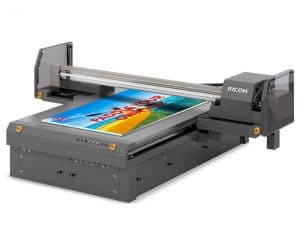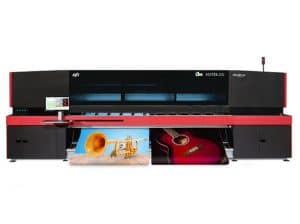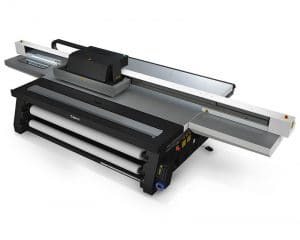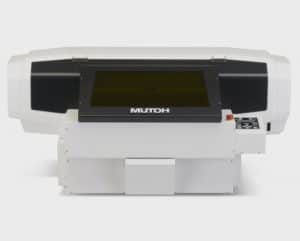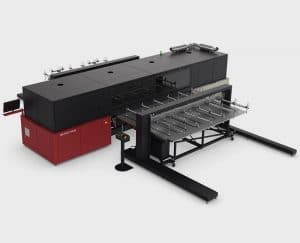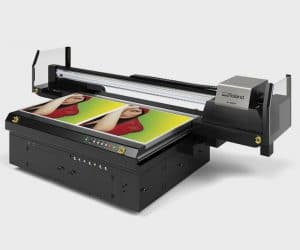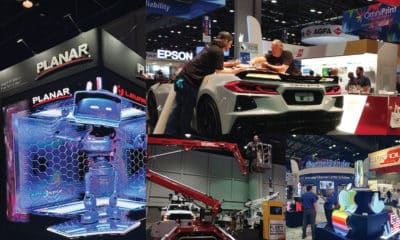SO, WHY DO SIGNMAKERS get so hyped when they hear about UV printers? The main thought has to be versatility. Few printers on the market can print directly on virtually any surface without the need for special coatings or preparation, so what makes these printers well-rounded? Of course, there has to be a catch; nothing is ever perfect. Let’s take a look so that you can see if UV is right for your shop.
It’s the ink that really sets these printers apart from other technologies. Instead of using heat and/or exposure to air, UV inks solidify when exposed to ultraviolet (UV) light. The concern of ink heads drying out is virtually eliminated, making maintenance easier. UV inks contain no VOCs, are safe for office use and can be easily disposed. The inks’ composition allows them to adhere to virtually any media. When deposited, the pigments are NOT absorbed into the media, essentially eliminating dot gain and thus providing sharp, vivid colors. Many machines provide flatbed tables and adjustable head heights that can accommodate thick and heavy media. Plastics, metals, ceramics and woods can be directly imaged with little to no preparation.
Many of the complaints about previous UV printers have been addressed. It used to be that UV printers were slow, but now you can find production models that can easily print 1,600 sq. ft./hr. Older-model UV lamps generated excessive heat and also had to be replaced often. Now you can find machines that use LEDs for lamps that generate significantly less heat and greatly extend lifespans. Another grumble was that the ink was brittle and would crease if printed on flexible media and then subsequently stretched (think of a vehicle wrap). These days, numerous companies offer ink formulations that can be stretched and are better protected against abrasion.
Consequently we’re leaving the biggest catch for last – the price. UV printers have traditionally been very expensive and, in fact, high-production models are still very pricey. Eco-solvent printers have always had a wide price range that accommodated virtually all sign shops. For UV printers, we are finally seeing some degree of range in the pricing. Typically, the application and media size will determine the price. For instance, specialty printers for ceramics, phone cases, etc., cost a little under $20K. Lower-end machines with auxiliary tables go for about $50K. A shop workhorse that will run at 600 sq. ft./hr. will cost $80K – $150K. If you have deep pockets and the need for speed, PLUS a very large format (e.g., 8 x16 ft. or greater), then prepare to shell out $250K and up.
UV printers are incredibly flexible and quickly gaining a foothold in today’s signshops, making product offerings to your customers almost endless. UV has penetrated the roll-to-roll market in an immense way and if you have no need for rigid media, start taking a look at those products as well.
PHOTO GALLERY (6 IMAGES)
Advertisement
 UV printers are becoming a staple of modern signshops for a handful of key reasons: their ability to print on almost any substrate without special coatings or preparation; ink composition and maintenance; improved output speed; and better range of pricing.
UV printers are becoming a staple of modern signshops for a handful of key reasons: their ability to print on almost any substrate without special coatings or preparation; ink composition and maintenance; improved output speed; and better range of pricing.

 Tip Sheet2 weeks ago
Tip Sheet2 weeks ago
 Real Deal2 weeks ago
Real Deal2 weeks ago
 Paula Fargo3 days ago
Paula Fargo3 days ago
 Photo Gallery19 hours ago
Photo Gallery19 hours ago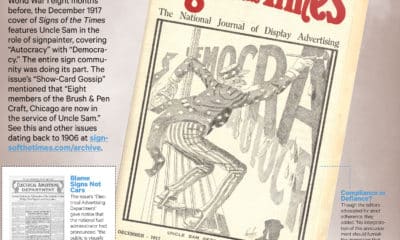
 Signs of the Times4 days ago
Signs of the Times4 days ago
 News1 week ago
News1 week ago
 Special Report1 week ago
Special Report1 week ago
 News1 week ago
News1 week ago
